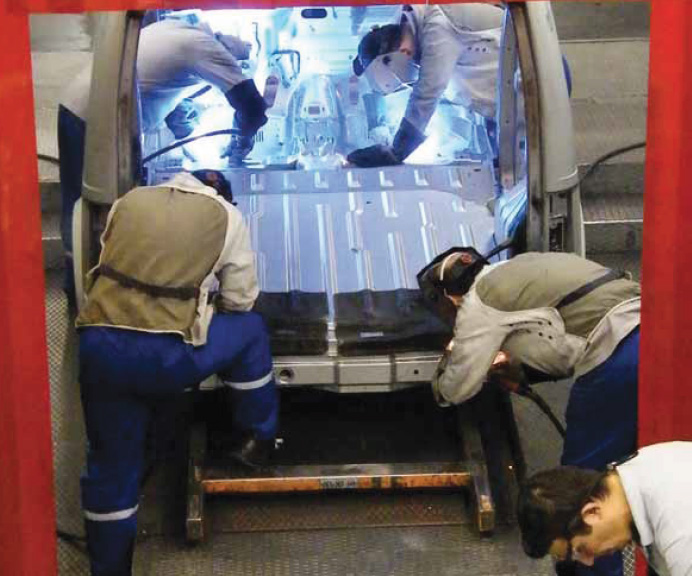
Ford Motor Company has long had a presence in Turkey. In 1928, the first dealership was established in Istanbul, selling imported models. In 1959 the carmaker’s first production plant was established in what was then an Istanbul suburb. Operated under the name Otosan – the name essentially translates to ‘“Automotive Industry in Turkey” – its products included small trucks, commercial vehicles and the Anadol passenger car. Featuring a steel chassis and a fibre-reinforced plastic “top hat”, the four-door saloon entered production in 1966.
To date, it remains the only vehicle to have been developed and produced by Otosan. Two-door and wagon versions were later added to the range, but by the late 1970s it had been replaced by the Taunus, a model largely based on the Ford Cortina. The last passenger car to be produced by Otosan was the Ford Escort, which was built between 1993 and 1999. According to Haydar Yenigün, plant
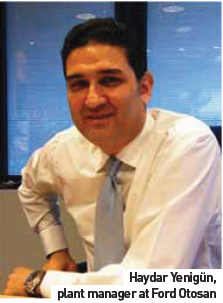 manager at Ford Otosan since 2007, it was just before the Escort was phased out that in 1997 that Ford and Otosan became equal partners and the Ford Otosan joint venture as it is today came into being.Up until this point vehicles were still being produced at the Istanbul facility, which over the ensuing years had been surrounded by the ever-expanding city suburbs. In order to gain much-needed space and improve both inbound and out-bound logistics, it was decided that a new greenfield plant would be constructed. It was also at this point that the company switched to production of commercial vehicles.“Up until 1999 we gradually shut down the Istanbul plant. In 2001, we officially moved to our present location, the Kocaeli plant, and in the same year we started building the latest version of the Transit for the local market,” says Yenigün. More than a decade later, commercial vehicles produced at Kocaeli are distributed around the world from a large import/export area adjacent to the plant. Yenigün says that up to four ships per week pick up vehicles from a lot that can hold up to 15,000 units.“We are now exporting between 70 and 80% of our production. We ship all our export vehicles, except those going Russia. These are trucked to Istanbul and on to the Black Sea before being shipped to the Ukraine,” he adds.
manager at Ford Otosan since 2007, it was just before the Escort was phased out that in 1997 that Ford and Otosan became equal partners and the Ford Otosan joint venture as it is today came into being.Up until this point vehicles were still being produced at the Istanbul facility, which over the ensuing years had been surrounded by the ever-expanding city suburbs. In order to gain much-needed space and improve both inbound and out-bound logistics, it was decided that a new greenfield plant would be constructed. It was also at this point that the company switched to production of commercial vehicles.“Up until 1999 we gradually shut down the Istanbul plant. In 2001, we officially moved to our present location, the Kocaeli plant, and in the same year we started building the latest version of the Transit for the local market,” says Yenigün. More than a decade later, commercial vehicles produced at Kocaeli are distributed around the world from a large import/export area adjacent to the plant. Yenigün says that up to four ships per week pick up vehicles from a lot that can hold up to 15,000 units.“We are now exporting between 70 and 80% of our production. We ship all our export vehicles, except those going Russia. These are trucked to Istanbul and on to the Black Sea before being shipped to the Ukraine,” he adds.
In addition to the Transit, the plant also produces and exports the smaller Transit Connect models. In 2011, 30,000 units were exported to the United States; in 2012 that figure will be closer to 40,000 units. Some of these vehicles were shipped ready to enter service as New York City taxi cabs. “Within Ford of Europe, we were the first company to export cars to America,” Yenigün proudly states. He adds that rather than vehicle lighting, glass or emissions, the main difference between US-specification models and those distributed in Europe is the powertrain. “In Europe the cars are largely fitted with a diesel engine and a manual transmission. US customers want a petrol engine with an automatic transmission. We have also found that Americans want to have major part numbers recorded on their log sheets, so we do that as well,” he explains. The shipping dock also receives a full range of Ford vehicles for local distribution. “We get all the passenger cars; Mondeo, Focus, Fiesta, Ka, C-MAX, S-MAX. We also get the Ford Ranger [pickup] from the ASEAN region.
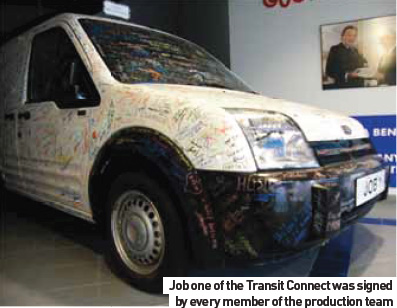 Power of three
Power of three
Currently, Yenigün has three major projects on the go. “We’re going to introduce three new products over the next three years. The first, which will be introduced by the end of this year, is a brand new global vehicle. This will be built within the existing plant on a separate production line,” he begins. “In 2013, we will launch the new Transit, which will be produced on the existing line after renovations and conversions have been completed. The third model is a brand new commercial vehicle, which will be built in a brand new plant, starting in 2014. This will feature new buildings, new tooling, new people, everything is going to be new.” Yenigün says that the new Transit project will be supported by an already-announced $1 billion (€750,000) of new investment capital. He adds that another announcement concerning a further package to support production of the other models is imminent. “There will be another big investment for the new vehicle. Three new vehicles, one new plant and 1,500 new people. It will be a bit of a nightmare!” he jokes. He agrees, though, that the expansion of both the product range and plant infrastructure is a vote of confidence in Ford Otosan. “We have improved out external quality metrics – internals were already in place. We have a great reputation within Ford for external quality.” In addition to these projects, Yenigün says that he is also involved in production of a global Ford Truck model. He says that after Ford sold its North American and European truck manufacturing operations to Freightliner (part of Daimler) and Iveco (part of the Fiat Group), the only remaining regions producing Ford Trucks were Turkey and Brazil. “Since Ford left this business there was no interaction, everything was developed locally, based on local needs. In Brazil the [truck] market is segmented differently to how it is here. Using the One Ford strategy, we convinced Ford to go for it again and now we’re going to combine to build a new truck, a new chassis and a new engine,” he says. Considering the current size of the global truck market, Yenigün believes it was a decision based on good business sense, stating: “We’re back, and I think this will be a growth area for us.”
Crisis and recovery
Ford Otosan’s Kocaeli plant is divided by a small river that empties into the Marmara Sea. To date, production operations 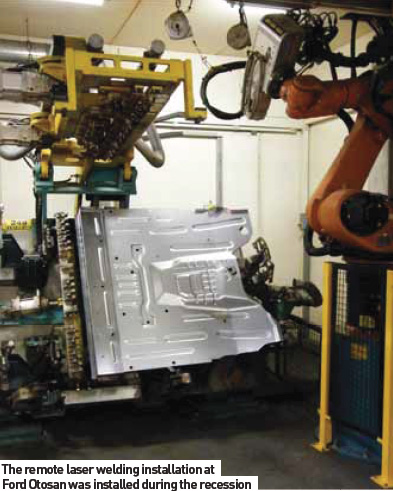 have been centred on the western side of the campus, while import/export activities are located on the eastern side of the river. Yenigün says that the new plant will be located on the eastern side, taking up what free space remains of the original site. “We currently have 345,000 sq m of production area which offers a maximum annual capacity of 320,000 vehicles. In 2014, [with the addition of the new plant] this will increase to 440,000 vehicles.”
have been centred on the western side of the campus, while import/export activities are located on the eastern side of the river. Yenigün says that the new plant will be located on the eastern side, taking up what free space remains of the original site. “We currently have 345,000 sq m of production area which offers a maximum annual capacity of 320,000 vehicles. In 2014, [with the addition of the new plant] this will increase to 440,000 vehicles.”
As of 2011, he points out that the plant was utilizing approximately 90% of available capacity, which translates to 285,000 units. This is a marked upswing in production when compared to numbers recorded over the recent downturn. “In 2007, we were heading towards 325,000 units over the first half of the year, but when we were hit by the economic crisis we went down to 25% of capacity. Over the last quarter of 2008 and the first of 2009, we were crawling on the ground. As I remember, we had to shut the plant for about 17 days per month and we had to lay-off some people. It was a very difficult time for us.
“I know what ‘lay-off ’ means in English, but it’s not the same in our case. When I say lay-off, I mean that we did not pay a full wage.” Yenigün explains that in a deal negotiated with the local union, Ford Otosan agreed to pay a “living wage” to employees over a period of up to six months while they were not working at the plant. “It was either that or I had to fire 2,000 workers,” he adds. Even with the agreement, had the downturn lasted beyond six months, firing workers would have been the only solution: “We were dead, there was no work,” he concludes.
Everyone at the plant was subject to some type of income reduction. Yenigün imposed a 25% pay reduction upon himself, while other salaried workers had to take a wage cut of between 10 and 15%. Beyond that, most of the third-party companies working at the plant were also let go. “I asked for volunteers to do the cleaning, except toilets and offices – I don’t think my technicians should be cleaning toilets – and for security, we had cleaners come in to take care of the offices.” The shipping agency responsible for moving cars from the plant to the pier was also let go. In total, Yenigün allocated 485 people to take care of various day-to-day operations across the company. “We sent the coffee people home. Our people got the same money, the same benefits, but instead of assembling a bumper they made tea.” The crisis extended from December 2008 to May 2009, over which time Yenigün says the plant was operating for only eight or nine days per month. At the very limit of the six-month period, production figures started to rebound. “We did two things over the downturn,” says Yenigün. “We did cleaning and renovation, and we also invested in new technology.”
One of the new technologies is a remote laser welding cell. Under the management of Ford Otosan, the project brought together the expertise of various companies and organisations including Trumpf, Kuka Systems and Kocaeli University. Yenigün says: “Instead of making the join from just a few centimetres away from the sheet metal, this system can make the join from a distance of up to 1.4 metres. We invested YTL1.7 million (€729,000) in this technology in the middle of the recession. I am very proud to say that this is the first time that Ford Otosan has added a totally new technology to Ford’s library of skills.”
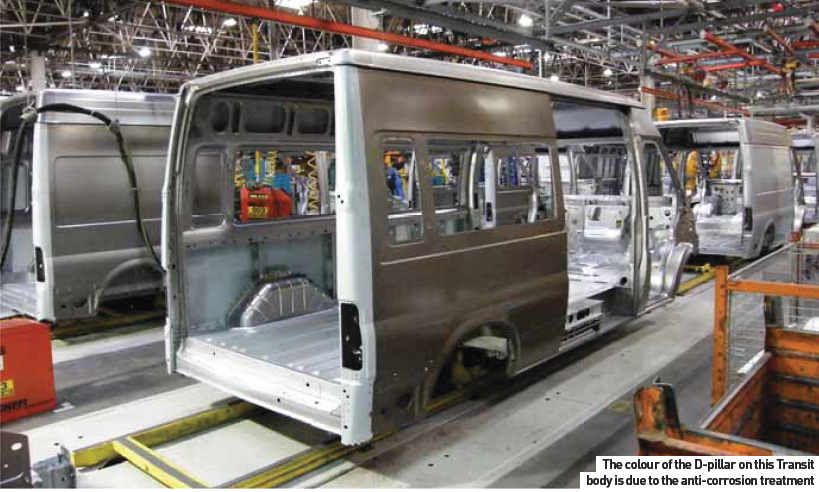 While he admits the new installation is a costly addition to the manufacturing process, it delivers a series of benefits. “I can get better quality using less energy and space – 25% less space. Also, as the robot has to move much less, the arm hardly moves at all, so laser welding takes 25% less time than conventional welding. You also need far fewer clamps than with spot welding, which reduces the tooling costs by 40%. And then there’s throughput – this was increased by 30%. Yes, it was difficult to get this signed off over the recession, but I’m happy we did it.”
While he admits the new installation is a costly addition to the manufacturing process, it delivers a series of benefits. “I can get better quality using less energy and space – 25% less space. Also, as the robot has to move much less, the arm hardly moves at all, so laser welding takes 25% less time than conventional welding. You also need far fewer clamps than with spot welding, which reduces the tooling costs by 40%. And then there’s throughput – this was increased by 30%. Yes, it was difficult to get this signed off over the recession, but I’m happy we did it.”
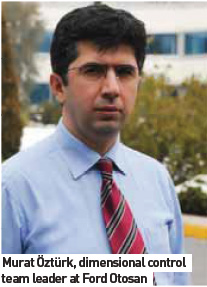
On a tour of the plant, Güner Demirural, engineering manager for body manufacturing explains more about the new remote laser welding installation. “Because the robot can make a join from such a distance, it allows a very different set-up [to traditional welding]. The robot simply has to look at, rather than travel to, a work area. On a part such as a floorpan, which is about a metre in length, the motion is almost zero. It can make 20 or 30 spots along the join, each in about half a second, which compares to about two to three seconds for a standard spot.”
According to Demirural, the laser can be programmed to produce welds in a variety of shapes, including arcs, esses and zigzags, the choice of which can greatly enhance the strength of the finished join. “The final weld results in a join that is about 20% stronger than a 6mm spotweld, which is the standard. It can be up to the same strength in one direction and up to four times the strength in the other.” For now, the 4kW laser installation is being used to join a limited number of parts, including the front floorpan, but future projects will see the system used for joining roof panels.
Flexible purchasing
Engines for production at Ford Otosan’s Kocaeli plant are delivered from the nearby Inönü facility. Outsourced castings are delivered to the plant before they are machined and assembled for delivery. Beyond that Kocaeli is a fullproduction site, which in addition to the standard range of manufacturing activities (press, weld, paint and assembly) includes a dedicated tool and die operation, which Yenigün says can help to cut costs.
“Everything we do here follows the rules that Ford has put in place in terms of safety, the environment and the Ford Production System. Everything is done in line with Ford. But when it comes to buying, I am more flexible than Ford because I can bargain. When you order a tool, Ford can perhaps have that delivered for $200 million (€150 million). I can do the same for perhaps $70 million (€53 million). I can split the order; you do dies, you do closures, etc.” One of the primary reasons behind the selection of the new site was its proximity to established suppliers. In addition to Ford, the area is a hub of automotive production, with plants from such companies as Honda, Toyota, Tofas, Renault and Hyundai all in close proximity to each other.
As such, can Ford Otosan benefit from discounted parts, leveraging local completion and Ford’s global buying power? “Sometimes we can get deals, but sometimes it also works the other way around,” says Yenigün. “In this business, there are not too many suppliers for specific items. For example, in the case of airbags, there are only two suppliers. Seats, maybe three. I say three as the Japanese and Korean guys are using their own suppliers. So you have Johnson Controls and Faurecia; we use JCI. But there are not five suppliers. For smaller parts, maybe then we could go to a local supplier, but they can have problems delivering the quantity of parts required.
“Essentially, we are free to make the decisions [covering part suppliers], but we have to follow the rules of Ford. Another example is when we go to a seat supplier, they also have to follow the same rules. Are they capable of carrying out their own seating tests? When you apply this rule, the vast majority of local suppliers are out, and this is a very important part of the manufacturing process.”
Conquering complexity
Virtually every vehicle that rolls off the assembly line at Ford Otosan is unique, owing to the number of possible vehicle configurations and customer options. Taking into account the different wheelbases, varying floor and roof heights, door combinations, seating arrangements and paint options, Yenigün estimates there are approximately six million possible vehicle combinations. “I used to build passenger cars and complain about the complexity,” he says. “Building commercial vehicles for various markets, now I understand complexity.”
The bodyshop features three full production lines; two for Transit production and one for Transit Connect. On the Transit line there are approximately 1,000 separate derivatives, excluding closures. Factor in Transit Connect and there are 1,300 different vehicle arrangements. As the plant has expanded, automation has been added to a greater depth, as Güner Demirural explains: “On the first line, installed in 2000, and on the second line, about 40% of all operations are automated. The latest line, producing Transit Combi, has about 45% automation.”
Does the plant feature a relatively high degree of manual operations in order to avoid having to programme the robotics for each separate model derivative? “Programming would be the easy part,” he replies. “The hard task is loading the parts. In many cases, to do that automatically would result in reduced efficiency.”
According to Demirural, production of vehicle subframes is largely manual, while the body outer is created using automation in order to achieve an almost invisible join. This includes the flexible framing station, which has two sets of gates that shuttle back and forth dependent on the wheelbase of the vehicle entering the cell. In the framing station, Demirural says that approximately 1,000 sensors check various elements of the procedure, while robots on the line are fitted with a vision system delivered by Perceptron check part and vehicle tolerances. Those vehicles falling outside the acceptable range are sent for analysis, which can result in rework or the body being scrapped.
Moving with the times
Individual part quality is crucial to the quality of the finished bodies at Ford Otosan. To improve the quality of individual parts, a representative sample is taken directly from the stamping lines for analysis in the plant’s metrology department. The process was previously carried out using a probe-based system, but recently this was replaced with the new XC65D laser-based cross scanner system from Nikon Metrology.
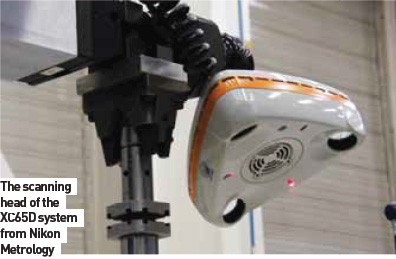 The XC65D is a three-in-one scanner, incorporating three laser/camera sets mounted in a cross pattern. This makes it possible to simultaneously capture data from different sides of a part. The scanner can also digitise slots, sleeves, holes and other features in a single scan. Although the system is designed for scanning geometric features, the cross scanner is equally suitable for digitizing freeform surfaces and edges. According to Murat Öztürk, dimensional control team leader at Ford Otosan, the new laser scanner offers a series of benefits which ultimately combine to deliver better parts to the bodyshop. “The touch probe was limited to testing a fixed number of points. With this new system, millions of points are generated over the scan. So you get better data about the part quality. In addition to that, this technology is very fast. The old system took hours to scan a given part, the new Nikon system will take about 30 minutes,” he says. The system can also be used for prototype parts. Öztürk notes that for these pieces, scanning the part allows individual data points to be selected. The system is not just limited to individual parts delivered from the stamping line. Subassemblies are also measured to check that they are within acceptable tolerances, while a whole vehicle can be moved into the testing area for analysis.
The XC65D is a three-in-one scanner, incorporating three laser/camera sets mounted in a cross pattern. This makes it possible to simultaneously capture data from different sides of a part. The scanner can also digitise slots, sleeves, holes and other features in a single scan. Although the system is designed for scanning geometric features, the cross scanner is equally suitable for digitizing freeform surfaces and edges. According to Murat Öztürk, dimensional control team leader at Ford Otosan, the new laser scanner offers a series of benefits which ultimately combine to deliver better parts to the bodyshop. “The touch probe was limited to testing a fixed number of points. With this new system, millions of points are generated over the scan. So you get better data about the part quality. In addition to that, this technology is very fast. The old system took hours to scan a given part, the new Nikon system will take about 30 minutes,” he says. The system can also be used for prototype parts. Öztürk notes that for these pieces, scanning the part allows individual data points to be selected. The system is not just limited to individual parts delivered from the stamping line. Subassemblies are also measured to check that they are within acceptable tolerances, while a whole vehicle can be moved into the testing area for analysis.
“A full bodyside analysis used to take half an hour,” says Öztürk. “We can now complete this in about 11 minutes.” The increase in testing speed also allows a larger representative sample to be analyzed. “In the same time we [used to] check four or five vehicles, with the Nikon system we can check 10 vehicles.”
Looking at the scanned data, colours are used to represent changes in the part from an ideal Z-axis measurement. Extreme minus deviations from the Z-axis are highlighted in blue, while extreme plus deviations are illustrated in red, with other colours used to represent other degrees of difference across the part surface. The fact that the Nikon system reviews the whole part surface rather than a limited number of points has also proved beneficial. Öztürk says: “Using the probe system, it was possible to miss some part deviations. Scanning the full surface of the part allows you to see surface imperfections such as dimples and scratches that could be related to tooling wear in the press shop.” Based on these reports, tooling can be checked and repaired in order to improve final part quality.
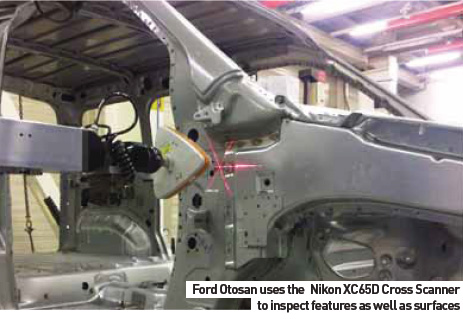 Güner Demirural says that the generated data is also used as the basis for reporting from the bodyshop. “We add the data into the report we produce to check the deviation between part and the assemblies we have built. This way we can check if the original part was at fault or if it’s our process that needs to be reviewed. The parts are like Lego, they can be put together in any number of different configurations; it all slots together. We have a lot of parts and small deviations here and there add up to big differences. In order to understand the end results, we look at all the data,” he says. “We are continuously monitoring the situation in order to achieve full repeatability. In some cases, we can even see problems before they happen. Using the Nikon system, we can see tooling degradation, follow that over time and we can decide to act on that before it creates a problem downstream.”
Güner Demirural says that the generated data is also used as the basis for reporting from the bodyshop. “We add the data into the report we produce to check the deviation between part and the assemblies we have built. This way we can check if the original part was at fault or if it’s our process that needs to be reviewed. The parts are like Lego, they can be put together in any number of different configurations; it all slots together. We have a lot of parts and small deviations here and there add up to big differences. In order to understand the end results, we look at all the data,” he says. “We are continuously monitoring the situation in order to achieve full repeatability. In some cases, we can even see problems before they happen. Using the Nikon system, we can see tooling degradation, follow that over time and we can decide to act on that before it creates a problem downstream.”
Öztürk says that the XC65D system from Nikon Metrology was installed in the plant about one year ago and following a period of training it went fully operational after six months. Now, the team at Ford Otosan is planning to retrofit six departmental CMMs with the same cross scanners, a move which is guaranteed to further improve throughput and finished vehicle quality.
Ultimate customer service
The goal of any carmaker is to deliver a fault-free product that every customer enjoys to the fullest. Yet even with such systems as that delivered by Nikon Metrology, this is not always possible, as Haydar Yenigün recalls. “We have found out that our customers in North America don’t like the way the rear washer function is set up [in the Transit Connect]. When they look at the steering column stalk, it doesn’t say ‘rear wash’. It’s the biggest criticism of the model in America, that there’s no tag on it.”
This and other messages are dealt with by customer complaints; if it’s a problem with a vehicle, these are immediately fed back down to the line. But in some cases, problems can be caused by the vehicle’s end user. Yenigün elaborates: “We contact every customer after a sale, and one was complaining about water ingress. That was a big shock. Water ingress is an indication of terrible quality. So I said to the quality supervisor, go there if you need to, find out what’s going on. We found the customer, who was in Boston, was actually talking about when he rolled down the window, rain would hit him in the face! He wanted one of those plastic shields fitted that would stop this. This is the level we’re at, this is the kind of quality issue we’re having now.”


































